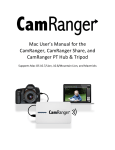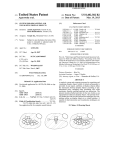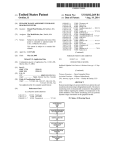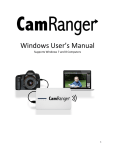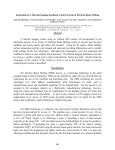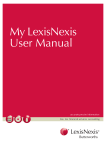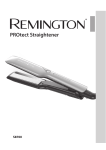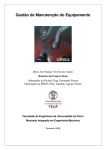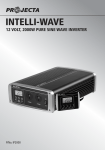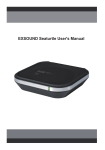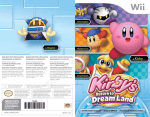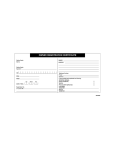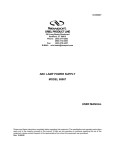Download Apparatus, system and method for tracking subject with still or video
Transcript
US 20130141588A1 (19) United States (12) Patent Application Publication (10) Pub. No.: US 2013/0141588 A1 Crookham et al. (54) (43) Pub. Date: APPARATUS, SYSTEM AND METHOD FOR Jun. 6, 2013 Publication Classi?cation TRACKING SUBJECT WITH STILL OR VIDEO CAMERA (51) (71) Applicant: MUSCO CORPORATION, Oskaloosa, Int. Cl. H04N 5/232 (2006.01) (52) US, Cl, IA (Us) CPC ..... .. H04N 5/23296 (2013.01); H04N 5/23216 (201 3 .01 ) (72) Inventorsl Joe P- Crookham, Oskaloosa, IA (US); USPC .................................... .. 348/157; 348/240.99 Douglas L. Roorda, Pella, IA (US) (73) Ass1gnee: MUSCO CORPORATION, Oskaloosa, IA (US) (57) (21) Appl' NO‘: 13/707’007 (22) Filed; Dec_ 6, 2012 An apparatus, method, and system for controlling camera aiming and operation through a convenient and intuitive inter (60) Related US Application Data Provisional application NO‘ 61/567,476’ ?led on Dec' ABSTRACT face using correlative touch and feel, Which alloWs a camera operator to primarily pay attention to a game or event, While simultaneously controlling a still or video camera in three control dimensions, With a high degree of accuracy or quality. 6,2011. 1001 Patent Application Publication Jun. 6, 2013 Sheet 1 0f 9 i001 40 US 2013/0141588 A1 Patent Application Publication Jun. 6, 2013 Sheet 2 0f 9 US 2013/0141588 A1 200 @6963) FIG. 2 Patent Application Publication Jun. 6, 2013 Sheet 3 0f 9 US 2013/0141588 A1 Patent Application Publication Jun. 6, 2013 Sheet 4 0f 9 US 2013/0141588 A1 Patent Application Publication Jun. 6, 2013 Sheet 5 0f 9 US 2013/0141588 A1 D?QQ Patent Application Publication 1s@\ 130\ M; 0 k 0 140 Jun. 6, 2013 Sheet 6 0f 9 o o o US 2013/0141588 A1 3*30\ 0 Y O v<3O" oO OO" 140 \ //'—~ A20 3136'“ 0O} 13 O A t A O U A 0 O O O O A O O O O O U 0 Patent Application Publication Jun. 6, 2013 Sheet 7 0f 9 FIE. ? US 2013/0141588 A1 Patent Application Publication Jun. 6, 2013 Sheet 8 0f 9 US 2013/0141588 A1 Patent Application Publication Jun. 6, 2013 Sheet 9 0f 9 US 2013/0141588 A1 Flow Chart — Calibration and Operation 9W3 iiiiiiiiiiiiiiiiiiiiiiiii " install camera on tripod/?xed location 92m f 925 METHODS 0 Capture image using live camera define target area on touch ‘ ““““““ c screen 0 install stock template 0 Capture image using other camera 0 Pull up image from file r, 90 f Q90 calibrate pan/tilt control to extents of target ‘ area PROCEDURE a touch corner 1; use PTZ control to move camera to corresponding orientation 0 Repeat for remaining three corners 0 touch calibration points within extents and use PTZ control to move camera to corresponding orientation [$45 94m compensate for included angle 4 error 980 95m begin recording Check input from touch pad Compare input to camera position Reposition camera SOFTWARE lNTERNAL OPERATlON ' software calculates scaling and zoom compensation for included angle area. Jun. 6, 2013 US 2013/0141588 A1 APPARATUS, SYSTEM AND METHOD FOR TRACKING SUBJECT WITH STILL OR VIDEO CAMERA video camera by methods that do not require constant or excessive Watching of a vieW?nder or video screen, and that alloW intuitive manual control of camera aiming. CROSS-REFERENCE TO RELATED APPLICATIONS advantage of the body’ s ability to accurately do multiple tasks [0001] This application claims priority under 35 U.S.C. §119 to provisional application Ser. No. 61/567,476 ?led Dec. 6, 2011, herein incorporated by reference in its entirety. repetitive motor skill. In other Words, using this ability, an [0005] I. BACKGROUND OF THE INVENTION This correlative touch and feel control should take simultaneously, especially in the case Where one task is a observer can both Watch an event and capture images Without having to choose one or the other, and Without signi?cantly distracting either from the enjoyment of Watching the event or from achieving high quality image capture. [0006] Kinesthetic control, described herein as correlative [0002] Many people, Who attend events such as sports games, concerts, Weddings, etc., desire to both Watch the touch and feel control is knoWn as a means of control of event and photograph or video record the event for later enjoyment. Currently it is very dif?cult to do both. Either one Will pay close attention to the camera and thus miss the enjoyment of the live event, or one Will concentrate on the live ment relies in general on common knoWledge of the human event, With the result that the photographic record of the event is of poor quality. Though it is possible to simply set a still html) and Charles C. MacAdam (see http://deepblue.lib. camera in a single location With, for example, a remote shutter release, or to place a video camera to record the entire sports playing area, the results of doing so are normally unsatisfac tory. Also, for sports and other events, one particular player or performer may be of special interest to a spectator (e.g., parents Watching their child playing basketball, performing on stage, etc.). But tracking a single individual back and forth doWn a basketball court or across a stage requires constant mechanical equipment. For example, While the present docu ability to control mechanical systems, papers by William T. PoWers “A Brief Introduction to Percepted Control Theory”@ 2003; (see http://WWW.frontier.net/~poWers_W/Whatpct. umich.edu/bitstream/2027 .42/ 6502 1/ 1 /MacAdami 2003%20VSD %20Understanding%20and%20 Modelling%20the%20Driver.pd? and Vehicles System dynamics, 2003, vol. 40, Nos. 1-3, pp. 101-134, SWets & Zeitlinger, incorporated by reference herein) provide an introduction to the theoretical basis for human control mechanical systems. Kinesthetic control is de?ned here as using ?nger, hand, arm, or other body movement in conjunc tion With a leamable physical and spatial interface, to control, attention and detracts from the enjoyment of the event. [0003] Servo control methods for operating still or video direct, or in?uence a physical result. The control motions may cameras are knoWn in the art. For example, the “AXIS 295 vidual piano key playing one note, or a computer key typing a single letter); may provide a signal that changes an obj ect’s Video Surveillance Joystick” commercially available from Axis Communications Inc. (100 Apollo Drive, Chelmsford, Mass. 01824) has a three-axis Hall-effect joystick, 12 pro grammable push-buttons and USB interface, and integrates With video surveillance softWare platforms recognizing joy stick inputs via Microsoft’s DirectX application program ming interfaces from Microsoft Corporation, Redmond, Wash. (USA). An example of video surveillance softWare is “Axis Camera Station” softWare, commercially available fromAxis Communications. Information about the AXIS 295 Video Joystick and AXIS Communications Software can be found at AXIS 295 Video Surveillance Joystick, Installation Guide@ Axis communications AB2006, Rev. 1.0, Part No. 26393; AXIS Camera Station USERMANUAL©, 2004-211, Ver. M2.7, Part No. 44738; and (P-Surveillance Design guide©, 2008; all from AXIS Communications, Inc., Chelmsford, Mass. (USA), and each incorporated by refer ence herein. Remote control pan and tilt units alloW an opera tor to control many parameters of camera operation; hoWever these units require the full attention of the operator to some kind of vieWing screen that is either attached to or remote from the unit. The result is that the servo control systems are little different from a simply Watching the event on screen or through a view?nder While manually controlling a camera and do not alloW for the user to enjoy Watching the event ‘live’ instead ofon a vieW screen. See also US. Pat. No. 6,977,678, incorporated by reference herein. correspond directly to a desired outcome (such as an indi position (such as the hydraulic control lever on a backhoe or excavator); or it may control the speed or other variable parameter of an object (such as the accelerator pedal on a car changing the car’s speed). In these cases, after a period of learning, the body adapts to touch and feel control Which provides either an absolute or relative reference to the desired output by either providing a one-to-one input/response sequence (eg the piano key), by making a change to the current state of the parameter being controlled (eg the hydraulic lever or accelerator pedal), or by making some other speci?c output response to a given physical input. [0007] Using correlative touch and feel to control equip ment is knoWn in many ?elds other than photography. For example, an automobile relies on the use of a “correlative touch and feel” interface Which requires an initial learning period, but Which can then be operated very naturally With little singular focus given to the psycho-motor skills Which are necessary. At ?rst, learning to drive an automobile requires intense concentration. The learner must grasp the relationships of the motion of controls (the steering Wheel, accelerator, clutch and brake pedals, gearshift, etc.) to the actual movement of the vehicle. And though the learner may control the vehicle very poorly at ?rst, he or she soon reaches a level of mastery that alloWs the vehicle to be controlled almost entirely by correlative touch and feel. This control sons Which alloWs the camera operator to enjoy the event in real time. Speci?cally, there is a need for an apparatus, sys tem, and method of kinesthetic control or “correlative touch alloWs the driver to vieW and enjoy the scenery While main taining smooth operation of the car. Control is maintained over different driving conditions such as city traf?c, express Way speeds, curving and uneven country roads, etc ., While the driver makes only occasional reference to the dash panel to glance at the speedometer and other instruments or to make and feel control” to control directional orientation of a still or sure of a control location. [0004] Therefore, there is need for a method, system, and apparatus for recording events and tracking subjects or per Jun. 6, 2013 US 2013/0141588 A1 [0008] Another example of this type of learned control of equipment is the operation of computer, ten key, and calcu continue the vehicle analogy, the same person can easily move from a very small compact car With an automatic trans lator keyboards. For example, While someone Who is neW to keyboard use may only be able to type a feW Words per minute, an experienced typist can input 50 to 100 Words per minute With almost no conscious thought applied to the loca mission and unresponsive acceleration, steering, and brakes, tion of the keys, beyond initially feeling the reference marks and an operator seat (and therefore an operator visual refer ence point) higher than the roof of most cars. typically found on the ‘F’ and ‘J ’ keys. And What is mentally tiring at ?rsti?nding the keys in the order of Words being scanned by eyeibecomes second nature so that the ?ngers for example, to a highly responsive sports car having quick throttle, braking, and steering response, to an over-the-road semi-tractor having a thirteen speed manual transmission, [0013] While such operator control has been applied to some things, such as discussed above, it has not been applied to others. In the case of automobiles, backhoes, and the like, the operator kinesthetic control translates minute human motor control of a relatively feW separate and dedicated con seem to respond almost independently of the eyes scanning a text that is being copied such that Words and sentences instead of individual letters seem almost to How from the keyboard. [0009] Other examples of this type of learned control of trols (e.g., steering Wheel, accelerator, brakes) into much equipment include ?ying airplanes; operating construction more poWerful mechanical forces and movements. In the case equipment such as a loader, backhoe, or excavator; control of musical instruments or computer keyboards, ?ne human motor control manipulates a larger number (e.g., standard piano has 88 keys, most computer keyboards have Well over 50 keys) of separate one-function controls (e.g., one key for ling softWare operations (such as eg photo editing software) using computer input devices such as a mouse, pointer, touch pad, etc.; and playing musical instruments such as piano, Control systems generally use a de?ned space to one note, one key for one letter) but to produce not mechani cal poWer or movement, but some quite different output (e. g., provide a general set of limits through Which the manual control takes place, based on various types of sensory inputs. For example, a car has an operator station (seat) Which posi Words). In these cases, the expense and complexity of the hardWare for kinesthetic control and the value of its output is accordion, xylophone, etc. [0010] tions the driver in a knoWn physical relationship to foot con sound energy or digital data that can be translated to letters or justi?ed. HoWever, those factors militate against kinesthetic trols (clutch, brake, accelerator), and to hand controls (steer control in other situations. ing Wheel, gearshift, turn signals, Wipers, radio, etc.). Within these bounds, through practice, the body quickly learns to art of photographing or imaging a live event. Given a short [0014] A need has been identi?ed for improvements in the provide inputs to the vehicle. The driver then interprets the time for learning, an operator of the system as described movements of the car by observing several types of input. The herein should be able to control a video or still camera, or even vieW out the Windshield is the most common input. Other inputs to the operator include the vieW in the rear-vieW mir rors, the position of a speedometer needle, presence or absence of indicator lights, the relative position of a tum signal lever, road noise and vibration, and even things such as the memory of the physical location of an outputisuch as the memory of the manual gearshift position after an up shift from multiple cameras, With very little conscious thought given to the process and With highly satisfactory results, based on the body’s ability to virtually automatically coordinate and assimilate multiple sensory inputs into a mental sense of the state of physical objects While performing other mental func tions, particularly When the ?rst function involves repetitive psychomotor skills. third to fourth gear. [0011] These inputs are organiZed by the brain to provide a “sense” of the car’s operation Which includes but is not lim ited to the visual perception of the location of the vehicle. Often inputs provide redundant feedback Which serves to either con?rm a single input or to “?ag” that input for veri? cation. For example, the sense of acceleration provided by the driver being forced into the seat (or more accurately in real physical terms, the seat applying a force to the driver) and the sound of the engine (volume and timbre), along With knoWl edge of gear selected, road conditions, and previous speed alloWs a driver to very closely estimate vehicle speed, such that a visual scan of the speedometer may only be made When a speed limit sign or police cruiser is sighted. This results in smooth and skillful operation of the vehicle by an experi enced driver devoting very little conscious attention to driv ing. In contrast, someone just learning to drive Will try to visually scan the speedometer frequently but is much more likely to control vehicle speed quite unevenly. As a result of the body’ s ability to process and interpret many inputs, some one driving a car is typically aWare only of making occasional visual reference to the vehicle speedometer to reassure and con?rm correct operation, When in fact a great number of inputs are simultaneously being processed and evaluated. [0012] Still further, the noteworthy adaptability of drivers to different vehicles shoWs hoW easily persons can “calibrate” their oWn sensory inputs to a varying control interfaces. To II. SUMMARY OF THE INVENTION [0015] Aspects of the invention as envisioned provide a method, system, and apparatus for controlling camera aiming and operation through a convenient and intuitive interface using correlative touch and feel, Which alloWs a camera operator to primarily pay attention to a game or event, While simultaneously controlling a still or video camera in three control dimensions, With a high degree of accuracy or quality. [0016] It is therefore a principle object, feature, advantage, or aspect of the present invention to improve over the state of the art and/or address problems, issues, or de?ciencies in the art. [0017] Aspects of the invention as envisioned can use a touchpad-type interface to provide tWo-dimensional ‘X-Y’ control With reference to a single plane (such as the horizontal plane of a basketball court, the vertical plane of action of a concert, Wedding, or other event) for camera pan-tilt. [0018] The touchpad may be an LCD screen or a tablet type computer such as an iPad®, With an interconnected camera, Wherein certain locations on the touchpad correspond to given locations Within an area such as a basketball court. [0019] The touchpad may be mounted on a camera tripod at a convenient location to alloW touchpad operation, or it may be hand-held or placed in the lap or on any available surface. A camera With electro-mechanical pan and tilt (PT) control can be mounted on a tripod or other suitable stable location. Jun. 6, 2013 US 2013/0141588 A1 Interface cables are connected to typical connectors on the touch screen unit. The touchpad may include a display screen. The camera may also be mounted remotely and connected by a cable or Wirelessly to other system components. A variable slide, trigger, or other input device can provide a third 7' or a convenient and intuitive interface using correlative touch and feel, Which alloWs a camera operator to primarily pay attention to a game or event, While simultaneously controlling a still or video camera in three control dimensions, With a high degree of accuracy or quality. “depth” control for camera Zoom (other camera functions such as focus, f-stop, etc. could also be controlled using the same trigger or another mechanism). The ‘Z’ control may be separate from the touchpad, or may be attached to or made as a part of the touchpad. [0020] Simultaneous enjoyment and imaging or recording of events is thus obtained. In one possible aspect of the inven tion, the combination of the tWo dimensional (2D) ‘X-Y’ correlative touch control With the 3rd dimension ‘Z’ trigger control can provide the heretofore unavailable ability to enjoy Watching an event such as a game or concert even While simultaneously capturing still or video images, Without los ing the accuracy of three dimensional (3D) control of the imaging camera. [0021] These and other objects, features, advantages, or [0035] B. Exemplary Method and Apparatus Embodiment l [0036] An embodiment according to aspects of the inven tion use a touchpad-type interface to provide tWo-dimen sional ‘X-Y’ control With reference to a single plane (such as the horizontal plane of a basketball court, or the vertical plane of action of a concert, Wedding, or other event) for camera pan-tilt. The touchpad may be of the type shoWn as item 20, FIG. 1, such as an LCD screen or a tablet type computer such as an iPad®, With an interconnected camera 50, FIG. 1 and FIG. 4, Wherein certain locations on the touchpad correspond to given locations Within an area such as a basketball court 100. aspects of the present invention Will become more apparent With reference to the accompanying speci?cation and claims. [0037] In one example, the basketball court displayed on touchpad 20 can be a rendering or graphically produced simu lation of actual basketball court 100 of FIG. 1. It could be III. BRIEF DESCRIPTION OF THE DRAWINGS highly styliZed or simpli?ed to display certain commonalities With actual court 100, (e.g., basic proportional siZe but not [0022] From time-to-time in this description reference Will be taken to the draWings Which are identi?ed by ?gure num ber and are summarized beloW. [0023] FIG. 1 illustrates one exemplary embodiment of a system of components according to aspects of the invention relative to an exemplary target (here a basketball court). [0024] FIG. 2 illustrates, in enlarged sale, touchpad 20 of FIG. 1, and illustrates an exemplary input point 200 on touch pad 20 corresponding to a given camera vieW. [0025] FIG. 3 illustrates an optional secondary camera 70 of FIG. 1 in enlarged scale. [0026] FIG. 4 illustrates camera 50 and pan and tilt unit 60 of FIG. 1 in enlarged scale, and illustrates a camera vieW 205 corresponding to a given touchpad input. absolutely required, landmarks such as outer court bound aries, half court line, free throW lines, positions of basket, and the like). In one example, the image of the court could be generic such that it could be reused for almost any basketball court. The concept Would be that the rendering or simulated image of the court on the touch screen provides visual indi cation of the basic geometry and landmarks on a basketball court. Another possibility Would be to provide an image of the actual court 100 on the touch screen display and have soft Ware that Would alloW the user to touch points around the boundary of the court as Well as landmarks like mid line, free throW lines, and basket positions, and then the softWare Would basically understand Where on the screen space the different locations on the court are. It Would be similar to putting in [0027] FIGS. 5A-B illustrate a touchpad 20 of FIG. 1 in enlarged scale and an overlay 110 that may be used according to aspects of the invention. [0028] FIG. 6 illustrates positional reference helps Which are used With overlay 110 and touchpad 20. [0029] FIG. 7 illustrates overlay 110 in use on touchpad 20. [0030] FIG. 8 illustrates an exemplary trigger control 210 of FIG. 1 in enlarged scale. Way points in a GPS system Which Would remember the points and their relative location to other points. In that Way, [0031] With commercially available Adobe Photoshop® softWare (available from Adobe, San Jose, Calif., US) to provide this FIG. 9 is a How chart of an exemplary calibration and operation method according to an exemplary embodi ment of the present invention. IV. DETAILED DESCRIPTION OF EXEMPLARY EMBODIMENTS [0032] A. OvervieW [0033] To further understanding of the present invention, speci?c exemplary embodiments according to the present invention Will be described in detail. Frequent mention Will be made in this description to the draWings. Reference numbers Will be used to indicate certain parts in the draWings. The a touch on the touch screen in operation Would then knoW Where the relative position of that touch on the touch screen Would be to the image of the basketball court, Which could then be correlated to the actual basketball court. For example, the Cintiq 2lUX Pen Display monitor (commercially avail able from Wacom Americas, Vancouver Wash.) may be used kind of interface. As can be appreciated from the foregoing, the basic concept is that What is displayed on the touch screen provides some visual representation of the event location (in this example a basketball court) such that signi?cant charac teristics like boundaries, and landmarks, can be discerned relative to the touching of a point on the screen such that all of the same can be correlated to the actual event location 100 (here basketball court 100). [0038] The touchpad 20 may be mounted on a camera tri pod 10 at a convenient location to alloW touchpad operation, same reference numbers Will be used to indicate the same or it may be placed in the lap or on any available surface. parts throughout the draWings unless otherWise indicated. [0034] Certain embodiments according to aspects of the Camera 50 With electro-mechanical pan and tilt (PT) control invention as envisioned provide an apparatus, system and method for controlling camera aiming and operation through 60 is mounted on tripod 10 or other suitable stable location. One example of a commercial PT control is the Bescor MP-lOl MotoriZed Pan Head, available from Bescor Video Jun. 6, 2013 US 2013/0141588 A1 Accessories Ltd., 244 Route 109, Farmingdale, N.Y. 11735. See also U.S. Pat. No. 7,527,439, incorporated by reference three corners of the court, then as many intermediate points (such as 200 of FIG. 2 as just one illustrative example) as are herein. [0039] Interface cables 40 are connected to typical connec necessary may be selected and calibrated. These points might include both ends and the center of the half-court line, the tors 3 0 on the touch screen unit. Touchpad may include screen 90, or screen 90 may be provided as a separate ‘monitor’ Which is used to shoW the current camera vieW. In this case, the screen 90 might be attached to a seat back in front of the three-point line. The ?nal step might be the user tracking multiple points on touchpad 20 While verifying that camera 50 is accurately vieWing the corresponding points on the operator, With the touchpad 20 in the user’s lap, While the court. camera 50 is mounted on a tripod at the end of the roW, in a [0044] Alternatively, the vieW screen on camera 50 could be used to indicate camera positioning relative to user input, apart from the use of screen 90. The user could simply point camera 50 to a desired vieW and touch the touchpad 20 in order to calibrate camera 50 to the touchpad area 90. After balcony, or other location Which provides a good vieW While not obstructing other observers. Camera 50 may also be mounted remotely and connected by cable or Wirelessly to other system components. [0040] A variable slide, trigger, or other input device pro center of each free-throW line, and tWo or more points on each calibration, the user Would provide input to the touchpad and vides a third ‘Z’ or “depth” control for camera Zoom. The verify using the camera vieW screen that camera 50 Was trigger control may be of the general type shoWn as item 210, FIG. 1 and FIG. 8, and may be separate from touchpad 20, or correctly folloWing touchpad inputs. may be attached to or made as a part of the touchpad. Other camera functions such as focus, f-stop, etc. could also be controlled using the same trigger or another mechanism. As can be appreciated, as With many commercially available trated in FIG. 9. computer peripherals such as joy sticks, ‘mouses, track balls, touchpads, Wireless gyroscope/accelerometer based control lers as With commercially available WiiTM (systems available from Nintendo Co. Ltd., Kyoto, Japan; http://WWWnintendo. [0045] An exemplary speci?c calibration method is illus [0046] Operation [0047] After calibration, the user can initiate the ‘record’ mode on the camera and simply tracks the action on the court With ?nger movement on the touch screen. Controls to inter face With the camera could be included in the touch screen interface and the trigger interface to alloW the camera to be paused, to Zoom in and out, or to control other camera fea tures. During the game, the user may reference the screen as com/?country:US&lang:en), the ‘Z’ or depth control could be a separate control device Which is manually operated. With much as desired to verify the camera is tracking accurately, regard to integrating it on a touch screen or on another control (e. g., additional buttons or controllers on a joy stick or Wire play to adjust or correct the calibration. and might take the opportunity during any interruptions in less controller), the designer could make such control easy to locate and access during operation. [0041] A true innovation in simultaneous enjoyment and imaging or recording of events is thus obtained. Speci?cally, display the actual area being vieWed by the camera. “Grab bing” and “panning” the vieW in the display could be used to the combination of the 2D ‘X-Y’ touch control With the 3rd dimension ‘ Z’ trigger control provides the heretofore unavail displayed on or represented by the touchpad. The concept of “grabbing” and “panning” is knoWn in the art, see http:// able ability to enjoy Watching an event such as a game or concert even While simultaneously capturing still or video images (such as illustrated by the screen 205 in FIG. 4) Without losing the accuracy of 3D control of the imaging The display on the touchpad, if used, might also control the camera instead of “pointing” the camera to an area WWW.globalmapper.com/helpv7/Help_ToolsMenu.html, User’s manual available at http://WWW.globalmapper.com/ helpV12/Help-Main.html. Some users might ?nd this inter face easier to use. It Would alloW veri?cation of the camera vieW and might be less susceptible to inadvertent movements camera. [0042] [0048] Calibration [0043] In one embodiment, for use, a calibration procedure is performed by the user, Wherein the camera 50 vieW is correlated to the touch screen. During this procedure, an overall vieW or representation of the court 100 (eg 105, FIG. 2) is generated and displayed on the screen 90. (Depending on the speci?cations of the camera and the location of camera 50 relative to the venue, this overall vieW may simply be a single Wide angle capture of the camera’s vieWing area, or it may be composed from multiple captures of smaller areas. Or a sepa rate still or video camera 70, FIG. 1 and FIG. 3, could be used to provide the overall vieW.) Then the boundaries of desired vieWing area, such as the corners of the playing court, are correlated to camera positions using a softWare procedure. (An example of such softWare is included beloW, see “Example of Camera positioning based on Touch Screen Input”). Again, an analogous example is the ability on a touch screen to place Way points on a map such that the GPS/map system remembers the Way points as Well as their relative location to other points on the touch screen. For example, the camera is positioned and Zoomed in accurately to the upper left corner of the court, and the user touches the correspond ing comer of the touch screen. This is repeated for the other of the camera tripod or mount. HoWever it might require more frequent vieWs of the touchpad in order to ensure that the camera is capturing the desired image, Which could in turn lessen the perceived bene?t of the device. [0049] Control [0050] Control of the camera PT unit 60 might be With a single ?nger tracing the action on touchpad 20. Based on programming and correlations betWeen the virtual display of the event location on touchpad 20 and the actual event loca tion relative to the actual camera 50, the ?nger tracing Would be interpreted by the softWare into instructions that Would geometrically be converted to change pan or tilt to change the aiming direction of the camera relative to the actual court 100. While this is a conversion of a tWo-dimensional ?nger trace on a tWo-dimensional surface into a court and camera in three-dimensional space, by calibration and programming, the correlations Would generally be suf?cient to move the camera ?eld of vieW in the intended manner of the ?nger trace. In other Words, the ?eld of vieW of the camera Would normally capture at least a substantial portion, as opposed to a small point, of the court. Thus, if the ?nger trace generally moves the aiming direction of the camera in the same intended Way as the ?nger trace it should be suf?cient to Jun. 6, 2013 US 2013/0141588 A1 normally capture the intended ?eld of vieW changes of the operator. The trigger 220 in FIG. 8 could be used to adjust camera Zoom by pushing the trigger forWard to Zoom in and pulling the trigger out to Zoom back. Of course, the Zoom concept Would be quite discretionary on the part of the opera tor. Such Would not change the aiming direction of the camera but rather the magni?cation of the recorded image. This also normally does change the siZe of the ?eld of vieW relative the actual court 100. The operator could glance at the camera display, if available, to double check ?eld of vieW. Alterna tively, the softWare might change the simulated ?eld of vieW on the touch screen to approximate the level of Zoom instructed to the camera to alloW the operator to glance at that for context. Another example could be a screen Within a screen on the touch screen that gives some feedback on ?eld of vieW. Other possibilities are Within the skill of those skilled in the art. The trigger 220 could provide feedback by trigger position, detents, engraved or embossed marks (such as e. g., “W”, “n”, “Z” in FIG. 8, for Wide angle/normal/Zoom), etc. to provide a reference for one or more intermediate Zoom levels. Also or alternatively, multiple or repeated ?nger movements on the touchpad (such as tapping or spreading tWo ?ngers apart for Zoom in, or touch-and-hold, or pinching ?ngers together for Zoom out) could be used. This type of touch screen manipulation is becoming ubiquitous With touch [0053] Just as With other learned skills, intentional refer ence Will normally be made by the operator to verify results, depending on the quality desired and the skill and aptitude of the operator. An operator Would be expected to carefully explore operation during set-up by looking at the screen and practicing camera control. The operator Would also be expected to glance at the screen from time to time during operation. Further veri?cation of results Would be obtained by replaying the still or video images; there could be imme diate bene?t to replay during time-outs, betWeen periods, etc. The operator Would also be able to bene?t from later play back, similar to hoW conventional photography and videog raphy is evaluated in post-action playback. Although the results of a recording session might be considered acceptable, the operator could still notice and correct their technique for x-y (location) and Z (Zoom) control, for example. [0054] C. Options and Alternatives [0055] The invention may take many forms and embodi ments. The foregoing examples are but a feW of those. To give some sense of some options and alternatives, a feW examples or additional discussion are given beloW. [0056] The touchpad could be separate from the screen. A dot, cursor, or highlighted area could be displayed on a sepa rate screen indicating the tracking position of the camera. Other input devices could be used such as a joystick, game screens on Smart Phones, iPads, and the like. Combinations of control inputs could be used as Well, such as separate buttons for full Zoom in, full Zoom out, and ‘normal’ modes and/or trigger use for in?nite variation betWeen extremes. controller, 3D mouse, etc. Feedback (e.g. vibration) could also be applied to these alternate controllers. Thus, in one embodiment, one hand Would control camera camera Would be calibrated to focus on one of nine separate Zones upon command. The user could press a single key to pan and tilt through the touchpad, and the other Would control camera Zoom through the trigger. Alternatively, the trigger, a knob, slider or other control could be attached to or integrated With the touchpad to alloW one-handed operation. The trigger might be integrated into a handle or grip that Would alloW one hand to comfortable hold the touchpad and control camera Zoom With the other hand free to operate pan and Zoom. Button 230, FIG. 8, on trigger controller 210 could be used to trigger a still camera image or to start recording; button 240 could display the still image or to stop recording. Other func tions/buttons are, of course, possible. [0051] The “Z” or “Zoom” control could be separately con trolled by a separate subsystem. For example, some cameras have Wireless remote controls that can control Zoom. [0052] Interactive, non-visual feedback might be provided from the touch screen to the user. Certain areas on the screen could be programmed to provide tactile feedback. For [0057] Many other input alternatives Would be possible. For example, a ten key style pad could be used, Where the indicate Which Zone the camera should focus on. Addition ally, “+” and “—” keys could be used to control camera Zoom. The “Enter” key could return the camera to a preset Wide angle vieW of the entire area. [0058] The touch interface could be ?tted With a custom guide plate or template, shaped like a typical court or ?eld. The template could have reference features that Would be easily identi?ed by touch Which correspond to locations on the court. In order to have such an overlay or template, touch screen operation Would have to be retained. This could be, for example, a transparency or translucent sheet over the touch screen that retains the underlying touch screen function of recogniZing placement of a ?nger or pressure at a point on the touch screen. An example of similar overlays is the collection of “CRL Quick-Draw Mirror Cut-out Templates” commer cially available from TechnologyLK (http://WWW/tecjmp; example, the user touching any area of the screen that corre sponds to an ‘out of bounds’ area could trigger a continuous pgu;l/cp,). This could improve the accuracy of the correlative touch and feel interface, by helping the user to control hand/ vibration from the touch screen or its housing. Or pre-desig ?nger movement With reference to the screen but Without having to look at the screen. This template could be as simple nated spots could give feedback to the useriperhaps varying intensity, duration, and intervals of vibrations to indicate cen ter court, near and far boundary lines, etc. One long vibration could indicate the center point of the court. TWo short vibra tions could indicate center point of the left free throW line; tWo long vibrations could indicate center point of the right free throW line, etc. Zoom levels could be preset (Within the bounds of camera capabilities) if the operator desired to limit Zoom-in or Zoom-out capability. Feedback from a hand-held touch screen based device or the like in the form of vibration, as a raised edge around the touch screen, or it could provide a detailed tactile model of the court, for example the markings on a basketball court might be overlaid on the screen (e.g., With embossments) so that the user could feel by just ?nger touch and trace around the 3-point line or the free throW line as the player of interest is moving on the court. Additional tactile reference points could be provided either at the edges of the screen or across the screen as desired. sound, visual signals (e.g., LED on/off or ?ashes) are Well knoWn and ubiquitous With regard to hand-held devices, par [0059] Multiple templates for different sports and events might be provided, a single template could be used, or the physical shape and feel of the touchpad could provide su?i ticularly With gaming applications or vibrating Smart Phones. cient tactile and spatial feedback to easily control the camera. Jun. 6, 2013 US 2013/0141588 A1 era coverage; for example a commentator/co-anchor could [0060] Camera controls could include a separate or inte grated remote function, such as a trigger or button (e. g. 230, have one or more cameras under his or her control in addition FIG. 8) to initiate recording. Multiple inputs could control to the cameras controlled by the director. Olympic type events camera functions. The remote could be connected directly to that ‘do not merit a full camera creW could be covered by one person With one or more cameras under control, alloWing the camera, or could be connected indirectly through the touchpad or controller. [0061] Customized Input Screen Example [0062] One example of a customiZed guided system is shoWn in FIGS. SA-B and 6. The screen is ?tted With a surrounding overlay 110, FIG. 5A, Which installs over touch pad 20; shoWn in side vieW. FIG. 5B shoWs overlay 110 ?tted to touchpad 20. Overlay 110 is ?tted With studs 120. Elastic loops 130, FIG. 6, can be hooked over studs 120. Addition ally, moveable markers 140 (e.g., small but tactilely discem able members), Which are designed to cling (e.g., electrostati cally or releasable adhesive) to the touchpad screen can be placed on the touchpad 20. In FIG. 7, loops 130 are shoWn fastened in a pattern that approximates Zones in the basketball court Which is displayed on the touchpad 20 (the ability to align the cord betWeen loops on selective studs 120 alloWs camera angle perspectives to be approximated for target greatly expanded video footage at very little cost. Churches or organiZations Wishing to broadcast services or events but having limited staff could assign a sound-board operator to control one or more cameras instead of needing a dedicated operator. A movie director or staff could control one or more cameras. [0067] [0068] Remote Use Many occasions exist When it Would be convenient for a vieWer to control a camera at a location Which is remote from the event to be recorded. For instance, relatives or team supporters Who are unable to personally attend a game or event might still Wish to Watch and record the actions of a child, grandchild, or other favorite player. LikeWise, those the court. Given the elastic bands marking the edges of each half of the court and the markers at reference points Within unable to travel With a high school or college basketball team might Want to record footage of a player or team from a remote location. [0069] Remote use ofa camera as discussed above might be enabled simply by mounting a camera to a tripod or ?xture in a sports venue and connecting via intemet to touchpad and trigger controls at any location With intemet access. A pri each court half, the user can easily approximate ?nger posi mary example is the increasing popularity of Web-casting tion on the touchpad With very little need to look at the college sports. Even mid-major or small universities or col boundaries). Additionally, moveable markers 140 have been placed to mark the center of the free throW line on each end of touchpad during play. This alloWs accurate control of the camera Without detracting from the experience of Watching the game. In other Words, the user knoWs each half of court 100 is bounded by elastic cord material having looped ends leges promote live video coverage of multiple sports events for fans such as parents that cannot attend. Many times resources (staff and equipment) result in a single static cam era vieW of the Whole court, or imprecise and burdensome tactilely feel the boundaries of either half of the court and manual pan/tilt/Zoom by an inexperienced operator. The present invention could alloW better presentation of the event, even by inexperienced operators. Additionally, it might make touch screen 90 Within that half to aim camera 50 there. If aim at or near the free throW line is desired, the button 140 in that angles. rectangle is located and the touchpad 20 touched there. [0063] Other customiZed guided systems that provided a [0070] [0071] tactile reference that couldbe correlated to positions on a ?eld or other target or camera space could easily be created, as long instance, a still camera could be used instead of a video camera. Multiple cameras in different locations could be interfaced to the computer or processor and calibrated to the 130, and the user knoWs each free throW line has a small marker 140. Without having to look at pad 20, the user can as a Way of tactilely identifying hand or ?nger position in relation to the input device is provided. [0064] Uses [0065] Aversion of the exemplary video camera system might be used for various indoor and outdoor sports such as basketball, volleyball, football, track and ?eld, etc. It could also be used for public events such as concerts, Weddings, plays, and so forth. Multiple screen overlays could be devel oped for different sports or ?eld types to provide ease in feasible multiple cameras for different coverage and vieWing D. Additional Options and Alternatives Many options and alternatives are envisioned. For touchpad, to provide multiple vieWs of the action. Multiple cameras recording With different formats, or settings, could be recording from the same location (one camera With a Wider angle setting for instance, in case the action is too quick to folloW, etc.). Cameras could be mounted above the court and controlled by touch. Cameras could be sWitched in and out by Zones, so that the closest available camera Was alWays in use. [0072] The calibration procedure is described above in adjusting to a given use. In any case, just as an experienced terms of camera having an elevated vieW of a horiZontal driver may sWitch vehicles With a quick glance at the controls, an experienced operator of this system might ?nd the calibra tion procedure to be very quick and the operation to be almost Without conscious thought. The result Would be the highly playing court such that the comers of the court are easily identi?ed. HoWever, for a camera located near the level of the desirable ability to Watch and enjoy sporting events, concerts, etc., While keeping a video record of the event for later enj oy ment. [0066] Use of the system could be expanded from con sumer use to institutional and professional use. Coaching staff could record practice or game action using one or more court, the calibration Would be oriented mostly toWards left and right pan, With the overall screen image being a side vieW of the venue. In this case, calibration Would primarily refer ence the amount of left and right pan of the camera and secondarily tilt up or doWn. This Would be the case for many events such as concerts or Weddings Where the touch control Would mostly be used for pan control of the camera. [0073] Additional Notes [0074] A separate camera in addition to the PT controlled cameras While or in addition to performing other tasks. (Cam eras could be mounted permanently for these uses.) Local TV stations could control multiple cameras With only one opera camera could be used to provide a full screen vieW. Or a single camera could be used such that the vieW on the screen Would tor. Large scale broadcasting operations could enhance cam represent the vieW being recorded by the camera. A non Jun. 6, 2013 US 2013/0141588 A1 visual touchpad could be used, most likely held in the lap, desired orientation, Whereupon the softWare Would report an With a separate screen positioned on the camera tripod for X/Y coordinate to the softWare. vieWing. Multiple displays or display areas could shoW the [0081] full court area for the touchpad interface as Well as the vieW from the PT-controlled camera. A split-screen vieW on a to a ?xed location such as a tripod orbalcony railing. A “Zero” function Would calibrate the camera position to its location. Then the user pan and tilt the camera to the shoW its farthest extents in each direction and to correlate those extents to the single screen could display camera space of plural cameras. [0075] A sports venue or other concern could also provide video feeds Which the touchpad interface or other interface Foruse, the camera couldbe positioned by clamping corners of the screen. These extents might be as folloWs: could control or access, either in real time or as a time-delayed or even post-game feed, to provide a customiZed video expe rience. The venue could rent or provide controls to an in house system, or provide interfaces to user-supplied record Touchpad Camera farthest extent Camera farthest extent corners ‘X’ coordinate ‘Y’ coordinate Al El A4 E4 X-30 X- 10 X-30 X- 10 Y0 YO Y- 1 5 Y- 1 5 ing equipment. Or user-oWned equipment could be interfaced With an in-house system. For example, an iPad could connect by cable or Wirelessly With the building system Which pro vides a video feed to the iPad. The user Would manipulate cameras built into the building by touch interface With the iPad Which Would relay the command to the building-based system. [0076] The system could be combined With a system using markers, transponders, or even face or number recognition (eg to track player jersey number) for camera control/sub ject tracking. In the case of automated subject (e.g., player) tracking there Would be certain periods during the game When the subj ect (e.g., player) might not be in play but game action [0082] Then the software Would divide the coordinates by the number of available positions on the touch screen so that the camera Would move evenly Within the prede?ned extents. The resulting correlated coordinates might be as folloWs, With “I” representing “touch pad control Input” and X andY rep resenting desired camera positioning coordinates): continued. Use of this invention in that case Would make it possible to continue recording the action. [0077] Example of Camera Positioning Based on Touch Screen Input [0078] In order to effect pan and tilt control of a camera in the manners described above, a touch screen may be used as in input device, With speci?c areas on the touch screen assigned to a camera position. Persons having skill in com puter servo control or computer numeric control (CNC) should easily be able to make this interface. One possible Way to provide this correlation is explained beloW. [0079] First, the screen is divided into discrete areas. For instance, a touch screen measuring 8 inches by 10 inches could be divided into 20 one-inch squares, identi?ed by roW indicators (numbers 1-4) and column indicators (letters A-E). The upper left comer of the screen Would be designated as “Al” and the loWer right corner of the screen Would be des ignated as “E4.” [0080] A pan-tilt camera control using stepper motors could then be calibrated to point to the appropriate physical location based on input from the touch screen, as Well as to provide feedback to control softWare of the actual camera position. For example, a camera could use tWo separate step per motors Which provide ?ne control of camera tilt and [0083] The result Would be that after the calibration proce dure, When the user touches the upper left comer area “A l ”, of the touch screen, the softWare Would direct the camera to move to X-30/Y 0; When the user touches the area “C3” near the center, the softWare Would direct the camera to move to Zoom. Such a camera could have a home setting designated as X0/Y0. A command to move (pan) the camera right or left X-20/Y- l 0. Would simply be a positive or negative X value. So if the camera could pan right or left 90°, the command “X-90” For instance, the screen could be subdivided into much Would move the camera 90° to the left; “X+90” Would pan the Zero to 255 and the vertical range into 56 or more, providing camera 90° to the right. LikeWise for vertical control, if the 256 individual ‘X’ positions and 56 individual ‘Y’ positions. A correction factor for distance (Which Would compensate for camera had a range of +/—20° from horizontal, a command “Y-20” Would tilt the camera doWn 20°; a command “Y+20” Would tilt the camera up 20°. Commands for position control [0084] The above example couldbe re?ned in several Ways. smaller areas; for example the horizontal range might be from a larger physical area being encompassed by a given degree control softWare, so that for instance the user could use a movement of the camera When the object is more distant) could be introduced, either by a software calculation or by manual correction. Further calibration methods are possible, such as a pixel-by-pixel correlation of the display screen and touchpad interface sensors to a PT position reference using joystick control, etc. to adjust pan/tile of the camera to a one or more identi?ed pixels from the camera. For pixel-by could range from “X-90/Y-20” (90° left, 20° doWn) to “X+90/Y +20” (90° right, 20° up) as one example. Addition, the coordinates for the camera position could be queried by Jun. 6, 2013 US 2013/0141588 A1 zoom, focus, and f-stop, and Which may be manipulated With pixel correlation, the extents of the target area Would be identi?ed as above, then each individual pixel or ?nest divi sion of the touch screen could be assigned a speci?c X/Y little or no visual reference to the interface. coordinate for the camera. an event at an event location While being able to Watch sub [0085] stantially continuously the event comprising: Example of Calibration Procedure 3. A method for a person to record by photograph or video [0086] FIG. 9 illustrates an exemplary calibration proce dure 900. Blocks correspond to general procedures or steps. First, FIG. 9, step 910, a camera is installed in a ?xed location a. positioning a camera (still or video) relative to the event such as on a tripod or attached to the building structure. Second, step 920, by one of several means, the target area is least a substantial portion of the event location; b. positioning the person to have a direct vieW of the event de?ned on the touch screen. This can include (925) capturing the entire target area as an image, installing an existing tem c. communicating change of aiming direction, zoom, or plate on the touchpad, capturing the target area using another camera, using an already existing image, etc. Third (930), the pan/tilt (and possibly zoom) controls are calibrated to the extents of the target area. (This can be done (935) by touching the upper left comer of the touch pad, then using the pan/tilt/ zoom controls to move the camera to the corresponding ori entation, so that When the screen is touched in the comer location so that its aiming direction is generally toWards the event location and its ?eld of vieW can capture at location; and ?eld of vieW instructions to the camera via correlative touch and feel control by the person Which does not materially disrupt or obstruct the person’s vieW of the event. 4. The method of claim 3 Wherein the correlative touch and feel control comprises one or more of: a. a touch screen; during operation, the camera Will move to vieW/record that b. a joystick; and area.) The procedure is repeated for the remaining three cor c. a hand held control With levers and/or buttons. 5. The method of claim 4 Wherein the camera includes ners. Then a su?icient number of points Within the target area are similarly addressed. Next (940) the system is compen sated for “included angle area” (When the camera moves a speci?ed number of steps or degrees, the amount of area on the target area that is sWept Will vary, depending on factors mechanized pan, tilt, and zoom capabilities. 6. The method of claim 5 Wherein the control is correlated to the mechanized pan, tilt, and zoom capabilities of the camera so that manual operation of the control produces a (945) that include the distance of the camera from the given portion of the target area.) This calibration can adjust so that correlated change on pan, tilt, or zoom of the camera. camera movements are smooth over the entire target area; still or video camera or both. also zoom levels might be adjusted for nearer and farther areas of the target area so that (for example) a player is displayed at the same relative screen size regardless of his or her position on the court. [0087] Once the camera system has been calibrated, the user can begin recording (950). At this point, the basic func tion of the system is to check for input (960) from the touch pad. Information from the camera positioning system is read by the system controller and compared (970) to the desired position. The camera aim is then adjusted (980) to provide the desired image requested by step 960. This process continually repeats during operation. [0088] Of course other normal camera functions Will be functioning simultaneously, and many other re?nements as discussed above are anticipated. 7. The method of claim 3 Wherein the camera comprises a 8. The method of claim 3 further comprising providing sensory feedback to the person relative to a change or aiming direction, zoom, or ?eld of vieW instruction. 9. The method of claim 8 Wherein the sensory feedback can be associated With at least one of: a. a particular aiming direction; b. a particular zoom setting; c. a particular point in the ?eld of ?eld; d. a boundary in the ?eld of vieW; e. a particular point of the event location; and f. a particular boundary of the event location. 10. The method of claim 9 Wherein the sensory feedback can differ for different associations. 11. The method of claim 8 Wherein the sensory feedback can be: a. tactile; 1. A system for correlative touch and feel control of still or motion picture cameras Which alloWs a vieWer to enjoy sport ing or other events While simultaneously controlling high quality capture of still or video images, comprising: a. a still or motion picture camera having a ?eld of vieW mounted on a support With a motorized pan and tilt control; b. a touch screen including a display adapted to present a representation of an event location comprising at least one of (i) the ?eld of vieW of the camera including at least a portion of the ?eld of vieW, and (ii) a rendering or obstruction of the event location; and b. audible; c. visual; or d. combinations of any of the above. 12. The method of claim 3 Wherein the positioning of the person is: a. at or near the camera; b. aWay from the camera at the event location; c. aWay from the camera at a different site than the event location. 13. A system for a person to record by photograph or video an event at an event location While being able to Watch sub stantially continuously the event comprising: c. softWare Which translates a user’s touch on a position on a. a camera With mechanized zoom, pan and tilt to alloW the representation on the touch screen into a pan and/or tilt to the camera correlated to the actual event location. tWo-degree freedom of movement adjustment of aiming 2. The system of claim 1 Wherein the touchscreen and softWare comprises a physical interface that correlates posi tion or other tactile or spatial reference to multiple camera settings relating to or comprising one or more of pan, tilt, direction and ?eld of vieW and zoom adjustment; b. a manually operated control operatively connected to the camera to control at least zoom, pan and tilt; c. a correlation betWeen the manually operated control and pan, tilt, and zoom of the camera to alloW correlative Jun. 6, 2013 US 2013/0141588 A1 touch and feel control of the camera to allow the person to adjust the camera during recording of the event With out material disruption or obstruction of the person’s vieW of the event. 14. The system of claim 13 Wherein the manually operated control comprises one or more of: a. a touch screen; b. a joystick; and c. a hand held control With levers and/ or buttons. 15. The system of claim of claim 13 Wherein the manually operated control comprises a touch screen and softWare Which: a. correlates a camera space image of the event location to a range of pan and tilt adjustments of the camera; and b. provides feedback to the person of present camera aim ing or camera ?eld of vieW position. 16. The system of claim 15 Wherein the feedback can be one or more of: a. tactile; b. audible; and c. visual. 17. The system of claim 16 Wherein the tactile feedback comprises physical structure on the manually operated con trol Which indicates some end of range of pan or tilt, or some characteristic or boundary of the event location. 18. The system of claim 17 Wherein the physical structure comprises one or more of: a. a tactilely discemable variation on the control; b. an adjustable member; c. a differentiated texture or surface. 19. The system of claim 18 Wherein the manually operated control further comprises camera record, pause record, stop record instructions or other camera operation instructions. 20. The system of claim 13 Wherein the manually operated control is in operative communication With the camera via one or more of: a. Wired; b. Wireless; or c. a combination of tWo or more of the above. 21. The system of claim 13 Wherein the pan and tilt control and the Zoom control are different. 22. A kit for a person to record by photograph or video an event at an event location While being able to Watch substan tially continuously the event comprising: a. a camera With mechanized Zoom, pan and tilt to alloW tWo-degree freedom of movement adjustment of aiming direction and ?eld of vieW and Zoom adjustment; b. a touch screen comprising a manually operated control operatively connected to the camera to control at least Zoom, pan and tilt; and c. softWare providing a correlation betWeen the manually operated control and pan, tilt, and Zoom of the camera to alloW correlative touch and feel control of the camera to alloW the person to adjust the camera during recording of the event Without material disruption or obstruction of the person’s vieW of the event. 23 . A method for a person to record by photograph or video an event at an event location While being able to Watch sub stantially continuously the event comprising: a. positioning a camera relative to the event location so that its aiming direction is generally toWards the event loca tion and its ?eld of vieW can capture at least a substantial portion of the event location; b. positioning the person to have a direct vieW of the event location; c. correlating the manually operated control and pan, tilt, and Zoom of the camera; and d. adaptively learning the correlation betWeen the control and the camera by practice or use; e. to alloW the person to acquire correlative touch and feel control of the camera to alloW the person to adjust the camera during recording of the event Without material disruption or obstruction of the person’s vieW of the event. 24. The method of claim 23 further comprising providing sensory feedback to the person to notify the person of some aspect of the pan, tilt or Zoom instruction relative to a prede termined parameter. 25. The method of claim 24 Wherein the predetermined parameter comprises: a. boundary of the event location; b. limit on range of pan, tilt or Zoom; or c. a feature in the event location. * * * * *



















